Our lab has had a long-standing interest in the subcellular, cellular and neural circuit bases of neurotransmitter and neuroreceptor actions and interactions across life span, spanning from embryonic development to the aged central nervous system. We use wild-type and transgenic mice, as well as a combinatorial array of classic and modern neuroanatomical, electrophysiological and behavioral approaches to shed light on questions related to how neurosignaling regulates the establishment of normal form and function of embryonic neurons and brain circuits, how normal function is maintained in healthy states, and how normal form and function do not develop in states of neurodevelopmental disorders. Through these foundational investigative efforts, an implicit goal is to identify potential targets for therapeutic intervention at the subcellular, cellular and neurocircuit levels.
To these ends, we use a mouse model of fetal alcohol spectrum disorders (FASD) to understand how exposure of the fetus to alcohol in utero results, in the short-term, in altered landmark developmental processes, notably neuronal migration, synapse and neural circuit formation, that persist indelibly as aberrant form and function in the disposition of neurons and neural circuits in the adult cerebral cortex and striatum. These studies are not only advancing our understanding of the embryonic etiology of FASD, but are also providing insights into our appreciation of other neurodevelopmental disorders with embryonic etiologies, such as autism spectrum disorder and attention deficit hyperactivity disorder.

